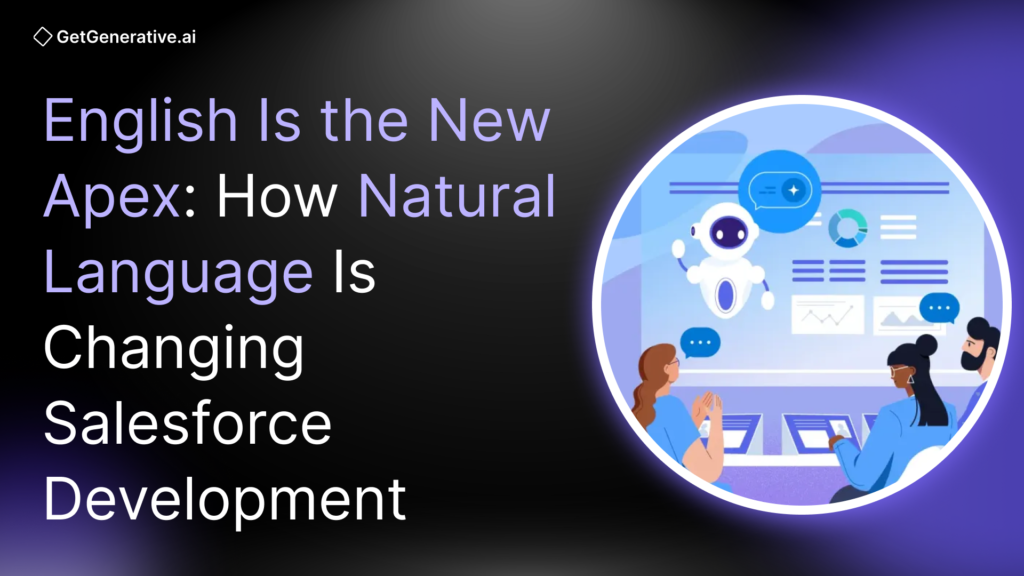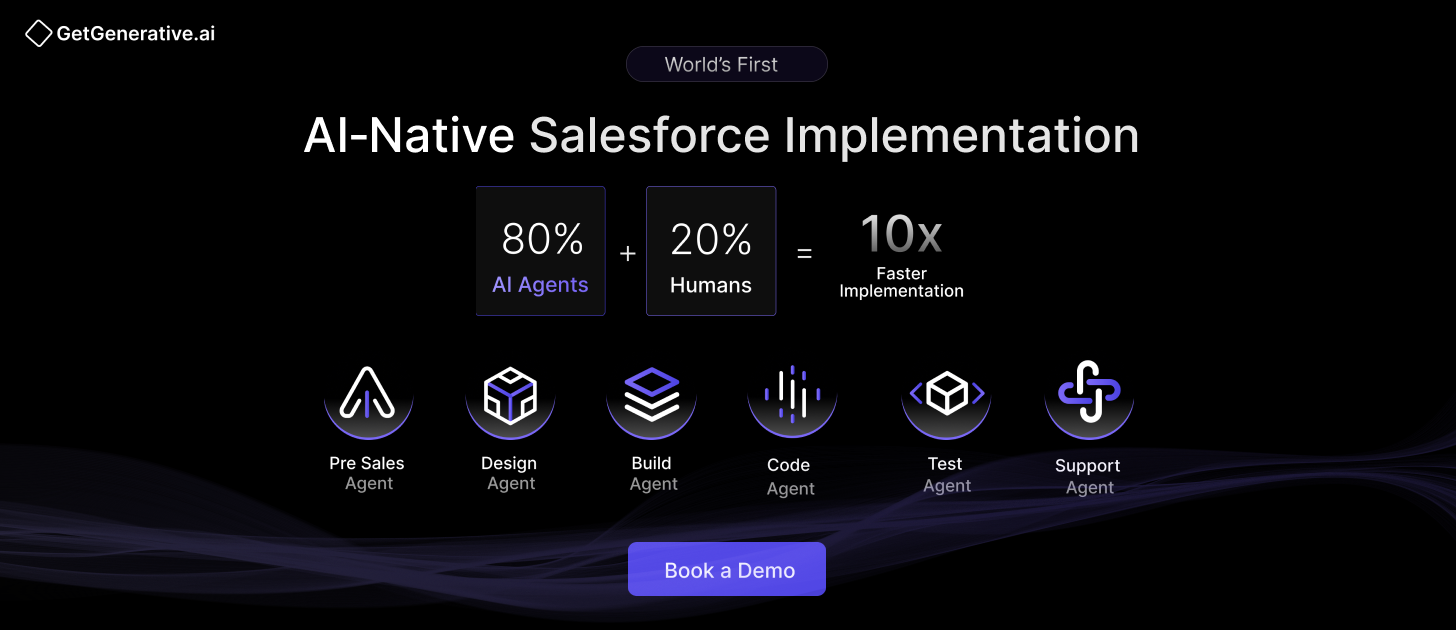English Is the New Apex: How Natural Language Is Changing Salesforce Development
Salesforce development is evolving rapidly. With the rise of generative AI, a new model of “intent-first” development is emerging, where developers and admins use natural language to generate Apex code, Flows, and Lightning Web Components (LWC). This shift, often referred to as “vibe coding” or “coding by intent,” allows professionals to describe their goals in English and receive structured, ready-to-deploy solutions in seconds.
According to recent industry reports:
- 76% of developers use or plan to use AI in their daily workflows (StackOverflow 2024).
- In the Salesforce ecosystem, 61% of admins and developers use AI daily, and 86% are actively exploring new AI use cases.
Salesforce’s own research underscores this evolution. Developers are becoming orchestrators of AI agents, shifting from line-by-line code writing to managing outcomes through natural language prompts.
What is Vibe Coding?
Coined by OpenAI’s Andrej Karpathy, vibe coding is an approach where developers write what they want, not how to build it. In Salesforce, this might look like:
“Create an Apex trigger to notify the sales manager when an Opportunity is Closed-Won.”
Salesforce’s AI interprets the prompt and generates a complete trigger, with best-practice implementations including bulkification, test classes, and error handling. This fundamentally changes the developer’s role — from code producer to strategic architect and AI collaborator
One architect explained:
“I’m no longer buried in syntax. I’m thinking about systems, integrations, and innovation.”
AI-Powered Salesforce Tools Transforming Development
Salesforce’s AI-native stack is designed to bring natural language to every corner of the development lifecycle. Here’s how:
1. Agentforce for Developers (Einstein for Developers)
This Visual Studio Code extension is at the heart of Salesforce’s AI push. Built on proprietary LLMs like CodeGen2.5 and xGen-Code, it supports:
- Natural Language Code Generation: Input a prompt and receive production-ready Apex or LWC.
- Inline Code Completions: Real-time suggestions tailored to your org’s metadata.
- Test Class Creation: Auto-generates unit tests based on your Apex classes or triggers.
- Code Explanation: Translate legacy or AI-written code into plain English with one command.
- Trust Layer Assurance: Salesforce’s Trust Layer ensures customer data stays protected and outputs remain compliant. No customer data is used to train LLMs.
Also Read – Agentforce for Developers: How to Build AI-Powered Solutions
2. Einstein Copilot and Prompt Builder for Flow Automation
Natural language isn’t just for coders. Salesforce now brings it to admins and declarative users via:
- Einstein for Flow: Converts prompts into Flow logic automatically.
- Prompt Builder: Helps teams create reusable, governed prompt templates that integrate live CRM data.
Admins can now say:
“Alert the Account Owner when an Invoice is overdue by 30 days.”
And the Flow Builder builds out the full automation — no dragging-and-dropping required.
3. ApexGuru – AI for Code Quality and Performance
Think of ApexGuru as your AI-powered code coach. It scans your Apex for:
- SOQL inside loops
- Improper DML patterns
- Missing bulkification or error handling
…and gives side-by-side comparisons and explanations. This is particularly valuable for junior developers and code reviews.
4. Einstein GPT and Copilot: AI Grounded in CRM Data
Launched in 2023, Einstein GPT connects Salesforce Data Cloud with LLMs for real-time, CRM-aware AI.
Use case:
“Generate an Apex trigger that creates a Contact when an Account is added — but only if the country is USA.”
Einstein GPT will:
- Check your org’s metadata
- Respect field-level security
- Output secure, context-aware code
- Log the interaction for auditing
Copilot ensures relevance; the Einstein Trust Layer ensures compliance.
Natural Language as a Developer Interface: Key Stats
- Salesforce’s internal tools like CodeGenie process 7M+ lines of code monthly, saving over 30,000 developer hours.
- GitHub research shows that AI pair programming can increase developer velocity by 55%.
- Surveys reveal 72% of Salesforce developers report higher productivity with AI tools.
These tools are not replacing developers — they’re augmenting them. And this productivity gain is reshaping team roles.
Related Read – A Beginner’s Guide to ApexGuru, Code Analyser, and DevOps Centre
AI-Driven Development: Transforming Roles, Teams, and Output
The shift from hand-coded Apex to natural language-driven development is not just about speed — it’s about redefining productivity and team dynamics.
Faster Prototyping, Faster Delivery
Salesforce teams now prototype in hours, not weeks. A recent Salesforce architect summarized:
“What used to take a week to build, test, and document — now happens in a single afternoon with Agentforce.”
Salesforce’s own tool, CodeGenie, has processed over 7 million lines of code, responded to 500,000+ developer queries, and saved an estimated 30,000 developer-hours per month.
From Developers to AI-Orchestrators
This change empowers developers to move up the stack, focusing on architecture, integrations, and business impact. One Gartner analysis calls this “the rise of the AI pilot”: developers who guide AI agents, validate results, and align them to strategic goals.
“The most valuable developers will be those who can collaborate with AI, not compete against it.”
Challenges And Risks: A Balanced View
While the promise is strong, responsible adoption is critical. Below are the primary challenges and how to address them:
1. Trust & Accuracy
AI can “hallucinate.” Salesforce warns that even its own LLMs can produce inaccurate or harmful code. Best practices include:
- Treat AI output as a first draft
- Require manual review + automated testing
- Use tools like Salesforce Code Analyzer and CI/CD validations
2. Data Privacy and Governance
Prompt-based AI can unintentionally expose sensitive fields or make decisions based on biased data.
Recommendations:
- Sanitize data inputs and prompts
- Leverage the Einstein Trust Layer to enforce security
- Use Field-Level Security and Shield Encryption
3. Lack of AI Literacy
AI tools are only as effective as their users. Surveys show that many developers still struggle with:
- Writing effective prompts
- Knowing what AI tools can and can’t do
- Understanding how LLMs interpret context
Solution: Invest in Trailhead modules, internal AI workshops, and cross-team collaboration.
4. DevOps & Metadata Complexity
AI-generated Flows, Apex, and configurations can introduce complex metadata dependencies.
Best practices:
- Use Git-based version control
- Treat prompts and agent configs as deployable assets
- Update your release pipelines to support AI-generated artifacts
5. Quality Assurance and Testing
With AI generating new artifacts quickly, QA becomes even more essential.
- Agentforce and ApexGuru can auto-generate test classes
- Run automated regression suites before every deployment
- Monitor code coverage and defect rates of AI-written components
Case Example: GetGenerative.ai’s AI-Native Model
One standout implementation of natural-language-first Salesforce development is GetGenerative.ai – the world’s first AI-native Salesforce implementation partner.
Key Highlights:
- 200+ Salesforce projects across 8+ countries
- 80% AI Agents + 20% Human Experts
- AI Agents include:
- Pre-Sales Agent (Proposal automation)
- Design Agent (User story + LLD generation)
- Code Agent (Prompt-based Apex, LWC, test generation)
- Test Agent (Automated test runs + Jira integration)
- Support Agent (Auto-resolves tickets from metadata history)
- Delivers 10x faster implementation compared to traditional partners
GetGenerative’s Code Agent works just like Agentforce — developers or BAs write prompts in natural language (e.g. “build a custom Apex batch job for deleting inactive Leads”) and the AI returns tested, deployable code.
Result: Enterprise Salesforce delivery in days instead of months, with deep integration into version control, CI/CD, and metadata governance.
Conclusion
The rise of natural-language development is not a gimmick — it’s a structural transformation. With tools like Agentforce, Einstein Copilot, ApexGuru, and platforms like GetGenerative.ai, Salesforce professionals are unlocking unprecedented speed, agility, and innovation.
At GetGenerative.ai, we’ve reimagined Salesforce implementation—built from the ground up with AI at the core. This isn’t legacy delivery with AI added on. It’s a faster, smarter, AI-native approach powered by our proprietary platform.
👉 Explore our Salesforce AI consulting services




